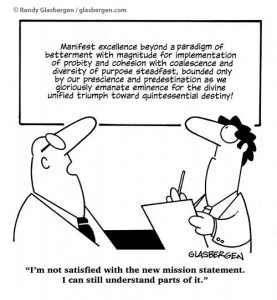My Week In BPM #18 – Communicating about a BPM implementation
Blog: Aris BPM Blog
In this month’s blog cycle I am sharing my thoughts and experiences around the topic of implementing BPM into an organization and just to be crystal clear, with “implementing BPM” I do not mean the technical installation of a BPM platform. No, I mean the adoption of a management philosophy that centers around the business process, and yes, of course, installing a BPM platform (for example: ARIS10) is a part of that, but it goes so much further. In this week’s blog I will stop at and contemplate on the communication topic once again (for I have done that on numerous occasions already).
During the inception of a BPM implementation, typically a dedicated project team has already spend some time on the justification part of the BPM project (setting up the business case, chasing down and convincing future ambassadors, appointing process owners for the future etc). This has most likely taken place in relative silence as the uncertainties around the implementation are still quite high. It is only after the formal approval of the executive management for the BPM project has been granted, that the project team starts to think about and is willing to start the communication. At least, that’s what you would think (and maybe even expect).
Nevertheless, in many cases, the project team is super excited that the project has been green-lighted, that they immediately continue with the actual planning and implementation part. And to be honest, there’s nothing wrong with that at all as long as the communication part is not forgotten. As I mentioned in last week’s blog on the planning of a BPM project, it is imperative that you start up the communication activities as early as possible, however this is not the main message of this week’s blog.
My main concern with communication efforts in BPM project has much more to do with the content, and more importantly with the tone and the perceived audience of the messaging. Even so often, BPM communications evolve around the “WHAT” and “HOW” and not around the “WHY”. Again, the WHAT and the HOW are important to cover, but it is the WHY that can increase the adoption of the BPM philosophy and thus increase the likelihood of success for your BPM project.
The reason for this comes from change management theories (I believe Simon Sinek covers this very elonquently as well with his slogan “ It starts with WHY”, here’s a link to a short video on this). People, in general, are more likely to adopt to a new reality at the moment that they (a) understand why it is important for them to change and (b) have some sort of influence on the way the change is being forced upon them. Especially, the (a) part stems from early human history where it was important to understand if the presence of a predator was threatening their very existence or not, and if so, they would very quickly make changes. Of course, anno 2021 this instinct has lost some of its power, but the fundamental principal is still ingrained in your lizzard-brain.
So, what does this mean for communicating on BPM? I believe that the project team should answer some questions in order to find the right message for the BPM communication. For example:
- How does BPM support me in my daily job?
- What does the BPM project mean for the way we run and improve our processes?
- What benefits will I have from the BPM project?
- What benefits will my department have from the BPM implementation?
The biggest mistake made in the communication around BPM (or also in other technical projects) is to focus on the functionality that is being rolled out. Look at what ARIS can do! We have implemented Teams! The new SalesForce roll out will make your life so much easier! Really? This might be all true but does not address the recipients immediate needs or delights.

In other words, when drafting the content for the messaging on the BPM project, put yourself in the recipients shoes and try to figure our what it means to them. For example for the subject matter expers (SME) the messaging needs to include the fact that having a single source of truth for processes significantly reduces the time they need to spend on documenting these, it greatly improves their capabilities to use business processes to explain or even train them to new users.
It needs to be as concrete as you can make it, tailored for the situation of the recipient. If you can keep those two guidelines in the back of your mind, your BPM communication will be much more effective and it will help to lower the thresholds for people to adopt to the new way of working, in this case: BPM.
Like L’Oreal used to say: because you’re worth it… and let’s tweak that a little: Because they’re worth it, with they being your end users, supporters, stakeholders and ambassadors.
Having said that, I wish you all a pleasant weekend.
Ciao, Caspar
Leave a Comment
You must be logged in to post a comment.









